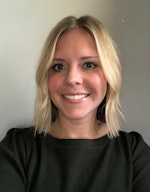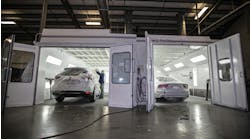The secret to boosting shop efficiency and profits should be no secret at all, says Michael Giarrizzo. Simply develop a predictable work process around a very unpredictable product.
Giarizzo, president of DCR Systems in Mentor, Ohio, has built his five-location business around this mantra. One of the principle founders of the Process Centered Environment (PCE) program with AkzoNobel — created in 2008 — he has used his experience to combine the methodologies of Lean Production, Six Sigma and the Theory of Constraints into a teachable process shops can implement within their own walls. At its core, PCE aims to help shops increase customer satisfaction, develop a team-oriented business culture, reduce waste in the repair process and ensure sustainable profitability through 10 key building blocks, which work together cohesively, or individually, based on a shop’s needs.
PCE’s 10 building blocks
- Continuous Flow — enabling work to flow without interruption
- In-process quality — embraces self inspection, successive inspection and standards
- Standardization — reduces variability by applying uniform criteria and practices
- Waste reduction — strategic identification and elimination of waste
- Continuous improvement — is a way of thinking that forms the basis of your business culture
- Pull production — work is drawn through the repair process with the use of deliberate signals to upstream operations
- 5S — a systemic approach to creating and maintaining a clean, organized and logical workplace
- Visual management — using displays, controls and fail safes to promote efficiency, safety and quality
- Real time administration — synchronization of administration activity with production activity
- Total productive maintenance — optimizing equipment availability and utilization
“There is no roadmap. PCE takes principles and brings them together in a work environment. We teach the thought process so the task is applied organically and differently to different environments,” Giarrizzo says. “The goal is to inspire others about how to bring the ideal of sustainability to their own shops. There is no perfect answer in a random work environment. So you need to break down your repair process and strip out the variables.”
Regardless of whom the shops are working to satisfy, the principles remain applicable. “There is always a debate about who your customer really is. But whether you are talking about the insurance company, the dealer or the consumer, they all want the same thing — a repair that is timely and cost competitive,” Giarrizzo says.
“The principles are simple, but a change from what we’ve been doing. It is a front-end loaded process. In health care, it is called pre-op. You make sure you have all the equipment, medicines, sutures and tools you need, because stopping in the middle of surgery isn’t an option. You need to create a continuous flow of work. From a sniffle to a heart attack, from minor to critical condition, each patient is handled in the same way. The same is true of the automotive industry.”
From the classroom to the shop
PCE training offers information and theory in the classroom, then owners or shop managers must take it back to their business for implementation. “As a leader, you can’t have someone else do this in your shop. The owner has to embrace the change,” Giarrizzo says.
“Each step can be tailored to an individual business. It about knowing what your business needs and how to interpret these concepts,” says Bob Gilbert, AkzoNobel Service Coordinator, who overseas all 15 service managers who facilitate PCE training in the U.S. and Canada.
Service consultants organize three to four two-and-a-half-day training sessions per year, and roughly 200 shops have taken the PCE course. About half of those have fully embraced the PCE culture, while the other half has applied specific steps, rather than the entire program, to address trouble areas in their business, Gilbert says.
Some of the training sessions take place right on location in Giarrizzo’s Mentor shop.
“We open our doors to those in training so they can see implementation of these ideas. It can help them
The architectural footprint of the Universal Collision Centre shop area was designed in an “open configuration” that includes repair stalls dedicated to specific repair processes and six empty parking stalls that remain open for use as a staging area.
strategically and sequentially to put the ideas in place. Many shop owners want to hold on to what they are accustomed to doing. But we really want you to think less about what you are doing, and more about why,” he says. “The goal is to inspire you to make change and create your own vision.”
Giarrizzo encourages all PCE attendees to stay focused on the thinking behind the process. It is a concept he learned while growing up in his family’s shop, which opened its doors in the 1940s and was later acquired by Sterling Auto Body in 1999.
“The thinking must precede the doing. People doing the work have to understand why they are doing it a certain way,” Giarrizzo says. “The thought process is simple. Prepare it up front. You need to believe ‘I can discover everything up front’ and then all the building blocks work. Whether parts, materials, technology, skills, resources, when you find what you need up front, you strip out tons of waste and redundant steps.”
The people perspective
Learning the PCE principles is only half the battle — shop owners and managers need the support of their technicians and employees before any success will be seen, Gilbert says. And it takes strong leadership and determination to implement changes, despite employee resistance.
“At times the training can be counter-intuitive to what they are used to doing. The industry hasn’t changed that much, so it can be hard to contradict or dispute what they have been doing in their business or shop for many years with a new concept or idea. There is some resistance to change,” he says. “We need to understand how to fix the people who fix the cars so that the benefit from a morale standpoint, as well as the business, wins financially when this happens.”
Once employees are on board, turnover often grinds to a halt, says Wheeler. “The people that succeed have very little turnover. “These are the owners that get their employees involved — they may change their pay, educate them, let them have input, and therefore have an impact on the process going forward. But the biggest challenge is employee buy-in. In this industry, if an owner gets enough pressure from his or her employees, they tend to go backwards. You have to be persistent,” he says.
Alpine Auto Body in Vancouver, Wash., sent General Manager Jim McCoy to the PCE boot camp in November 2008. He returned to the shop with new ideas for the three-location shop and used determination to conquer the challenge among the shop staff.
The Alpine Auto Body shop team conducts a daily Production, Standards and 5S audit. On the wall (upper left) is the Re-assembly Process board; with the Production Process board (middle right) showing all of the cars currently in process and where they are in production. The team from left to right is: Ray Alexander – Painter, Joel Thornburg – Manager, Jim McCoy – General Manager, Wayne Turvey – Body Tech and Andrew O’Lear – Estimator.
“We determined to start our PCE journey with a collaborative team mentality, not as a ‘forced’ change. Together with Alpine’s owner, Rod Cook, we met with our staff from each shop location and began sharing the value that PCE could bring to the team,” said McCoy. “For example, we told them that if we could lower our cycle time, we might get additional work from our insurance partners, or gain new ones who would hear about our improvements. That is exactly what has happened and the payoff really got the team excited to continue on.”
Through joining an area PCE User Group in 2009, and other hands-on training gained through AkzoNobel’s National Performance Group meetings beginning in 2011, Alpine has steadily added new PCE components to their operations.
The benefits reaped through PCE aren’t just about time and costs savings — it’s about the boost in customer loyalty. “We want to completely change our customer’s perception about the stereotypical body shop they are accustomed to and help them see Alpine as a professional, clean and organized facility where they can bring their vehicles and feel confident that the job will be done right the first time. We actually use our shops as a selling tool because when we tour customers around, we can see their perceptions change right in front of us,” McCoy says.
Repair focus
For shops not looking to completely immerse themselves in the PCE ideals and training, they can focus solely on improving their repair process.
The training is designed to educate shops on the proper implementation of repair planning — one of the PCE building blocks — and how to maximize production. Akzo created the training session blueprint by reaching out to champion PCE shops for repair planning best practices, says Scott Wheeler, North American Western Region Services Manager with AkzoNobel.
“PCE training focuses on the concepts. Repair planning teaches best practices, and as a result, these shops are learning some of the PCE concepts and gaining exposure to PCE that way,” he says.
Amending the repair planning process has been especially beneficial at Alpine Auto. With a repair planner stationed at each shop location, Alpine has effectively reduced insurance supplements by 75 percent and re-assembly cycle time by 50 percent, Manager McCoy says.
Driving global change
The PCE program is not limited to North America — Akzo offers services in Europe, Asia and Australia, and is now looking to enroll shops in Mexico, Brazil and South America, Wheeler says.
But the U.S. and Canada have returned the greatest implementation, he says. “North America has probably done the best job of driving these sustainable ideals into their collision centers. Here we have a lot of opportunities to change things, engage differently, and a lot of business owners are looking for a better way of doing things. The program has responded.”
Inside the lobby area of the 40,000-square-foot Universal Collision Centre facility.
Universal Collision Centre in Regina, Saskatchewan, Canada began their formal PCE training during construction of a new facility to house their two dealership locations and a body shop. A longstanding relationship with Robert DuBreuil, AkzoNobel Canadian Senior Services Consultant, had led co-owner P.J. Morris to implement small 5S steps over time — which would become some of the building blocks of the PCE program. The changes yielded both labor and material savings, and eventually led to opportunity for Morris, with insight from DuBreuil, to build a brand new shop as a flagship PCE operation.
During construction in 2008, Morris attended a PCE boot camp at DCR Systems in Mentor, Ohio, and began sending his employees to AkzoNobel boot camps held at Kelowna Performance Collision in Kelowna, BC, owned by Pete Facinek—the first adopter of the PCE program in Canada and passionate supporter of other owners who are interested in learning how to implement PCE in their own shops.
“There is no magic bullet to PCE and it takes a lot of hard work and at least one-and-a-half to two years to see the full scope of change,” said Morris. “But with the help of AkzoNobel’s ongoing support, I can tell you that the methodical implementation of each PCE component has not only brought everyone’s stress level down, but has created a predictable flow to our work environment that promotes an open, honest culture of trust and communication among employees, consistency in customer satisfaction, and a measurable increase in our bottom line year-over-year.”
The success of the PCE program continues to gain traction both among independent shops and especially with MSOs. “Every major consolidator, every MSO, is looking at this. They are working to figure out ‘how do we do this with the least resistance?’” says Wheeler, who has worked as an ABRA consultant and is currently onboard with Caliber Collision. Akzo also does all the repair planning training for the Toyota certification program.
They are also getting a lot of interest from insurers about the benefits of the process, Giarrizzo says. “It is about how we create sustainable value for both customers in the long term and for the employees by removing the waste,” Wheeler says. “We work to build all-around value and satisfaction.”
With the touted benefits does come challenges — engaging in the PCE journey requires both mental and financial fortitude, McCoy says. “It is not an easy transition to go from a traditional shop model to a true PCE culture, but it’s certainly worth it. AkzoNobel continues to provide ongoing support at every turn, and we’re always stretching and growing as a team. We have been on a four-and-a-half-year journey that will never end; and we enjoy our work all the more because of it.”







